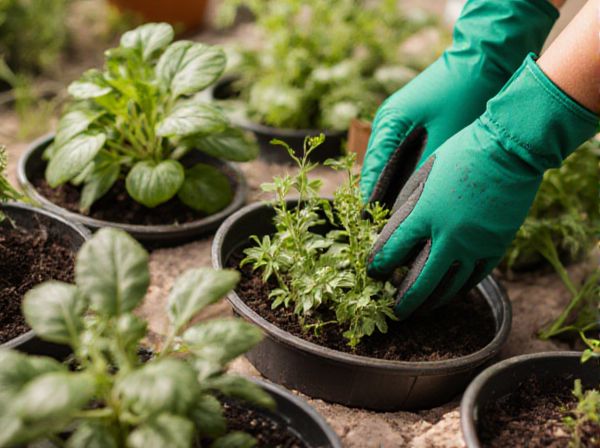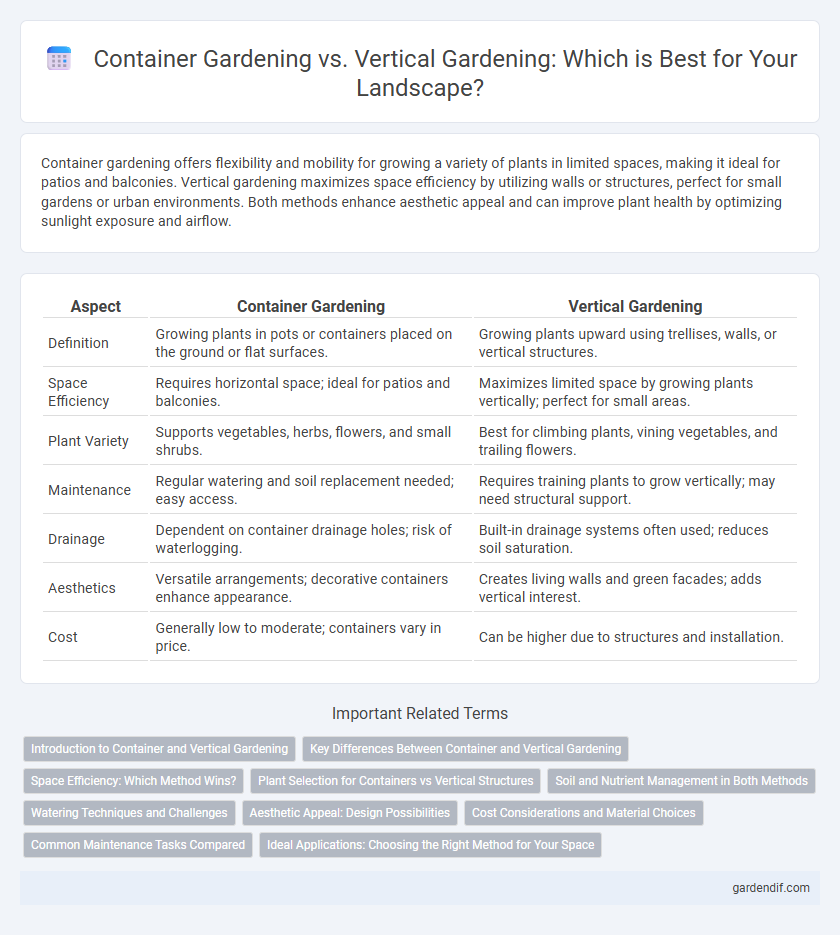
Container Gardening vs Vertical Gardening Illustration
Container gardening offers flexibility and mobility for growing a variety of plants in limited spaces, making it ideal for patios and balconies. Vertical gardening maximizes space efficiency by utilizing walls or structures, perfect for small gardens or urban environments. Both methods enhance aesthetic appeal and can improve plant health by optimizing sunlight exposure and airflow.
Table of Comparison
| Aspect | Container Gardening | Vertical Gardening |
|---|---|---|
| Definition | Growing plants in pots or containers placed on the ground or flat surfaces. | Growing plants upward using trellises, walls, or vertical structures. |
| Space Efficiency | Requires horizontal space; ideal for patios and balconies. | Maximizes limited space by growing plants vertically; perfect for small areas. |
| Plant Variety | Supports vegetables, herbs, flowers, and small shrubs. | Best for climbing plants, vining vegetables, and trailing flowers. |
| Maintenance | Regular watering and soil replacement needed; easy access. | Requires training plants to grow vertically; may need structural support. |
| Drainage | Dependent on container drainage holes; risk of waterlogging. | Built-in drainage systems often used; reduces soil saturation. |
| Aesthetics | Versatile arrangements; decorative containers enhance appearance. | Creates living walls and green facades; adds vertical interest. |
| Cost | Generally low to moderate; containers vary in price. | Can be higher due to structures and installation. |
Introduction to Container and Vertical Gardening
Container gardening offers a versatile approach to landscape design by using pots, planters, and containers to cultivate flowers, herbs, and vegetables in limited spaces such as balconies or patios. Vertical gardening maximizes space by growing plants upward on structures like trellises, walls, or specially designed frames, ideal for small urban environments or enhancing visual interest. Both methods provide efficient solutions for urban gardeners aiming to optimize space and create sustainable, aesthetically pleasing green areas.
Key Differences Between Container and Vertical Gardening
Container gardening involves growing plants in individual pots or containers, allowing for mobility and flexibility in plant placement, ideal for small spaces or patios. Vertical gardening maximizes limited space by growing plants upward using structures like trellises, living walls, or vertical planters, enhancing airflow and sunlight exposure. Key differences include space utilization, plant variety compatibility, and maintenance requirements, with vertical gardening better suited for climbing or trailing plants while container gardening supports a broader range of species.
Space Efficiency: Which Method Wins?
Container gardening maximizes space by allowing plants to be placed on patios, balconies, or small urban areas, making it ideal for limited ground space. Vertical gardening leverages vertical surfaces such as walls, trellises, or towers, effectively increasing planting area without expanding the footprint. For space efficiency, vertical gardening often wins by utilizing unused vertical dimensions, enabling higher density planting in compact environments.
Plant Selection for Containers vs Vertical Structures
Container gardening requires selecting plants with compact root systems and tolerance for restricted soil volume, such as herbs, succulents, and dwarf vegetables. Vertical gardening favors climbers, trailing plants, and species with strong tendrils like peas, beans, and ivy that can easily attach to trellises or wall structures. Choosing drought-resistant varieties optimizes water retention and growth in both container and vertical garden settings.
Soil and Nutrient Management in Both Methods
Container gardening requires careful soil selection with well-draining potting mixes enriched with organic matter to maintain nutrient availability and prevent root rot. Vertical gardening often uses lightweight growing media like coco coir or hydroponic substrates that provide efficient nutrient delivery through drip irrigation or nutrient film techniques. Both methods demand regular monitoring and supplementation of nutrients to support optimal plant growth and prevent deficiencies in confined soil environments.
Watering Techniques and Challenges
Container gardening requires consistent watering as soils dry faster due to limited volume, demanding frequent monitoring to prevent plant stress. Vertical gardening poses challenges in even water distribution, often necessitating drip irrigation systems or self-watering planters to maintain moisture across multiple layers. Both methods face water runoff and evaporation concerns, making efficient watering techniques essential for healthy plant growth.
Aesthetic Appeal: Design Possibilities
Container gardening offers versatile design possibilities with a wide range of pot styles, colors, and arrangements that can be tailored to enhance any landscape or patio space. Vertical gardening maximizes limited space by creating living walls and eye-catching green structures, adding height and texture that transform plain surfaces into vibrant focal points. Combining container and vertical gardening techniques results in dynamic, multi-dimensional garden aesthetics that elevate outdoor environments.
Cost Considerations and Material Choices
Container gardening typically involves lower upfront costs with readily available pots made from plastic, ceramic, or terra cotta, offering versatility and ease of relocation. Vertical gardening may require a higher initial investment due to structural components such as trellises, wall-mounted planters, or specialized frames, often constructed from metal, wood, or recycled materials. Selecting durable, weather-resistant materials in both methods significantly influences long-term maintenance expenses and overall cost efficiency.
Common Maintenance Tasks Compared
Container gardening requires regular watering, soil fertilization, and pruning to ensure healthy plant growth, with the added task of monitoring drainage to prevent root rot. Vertical gardening demands consistent checking of structural supports, frequent watering due to faster soil drying, and periodic nutrient replenishment, especially where soil volume is limited. Both gardening methods benefit from pest control and seasonal plant rotation, but vertical setups often require more intensive maintenance to manage plant weight and stability.
Ideal Applications: Choosing the Right Method for Your Space
Container gardening is ideal for small patios, balconies, or areas with limited soil access, allowing for versatile plant selection and mobility. Vertical gardening maximizes space by utilizing walls or vertical structures, making it perfect for urban environments or small yards in need of efficient greenery solutions. Selecting the right method depends on available space, plant types, and desired aesthetic impact.
Container Gardening vs Vertical Gardening Infographic

 gardendif.com
gardendif.com